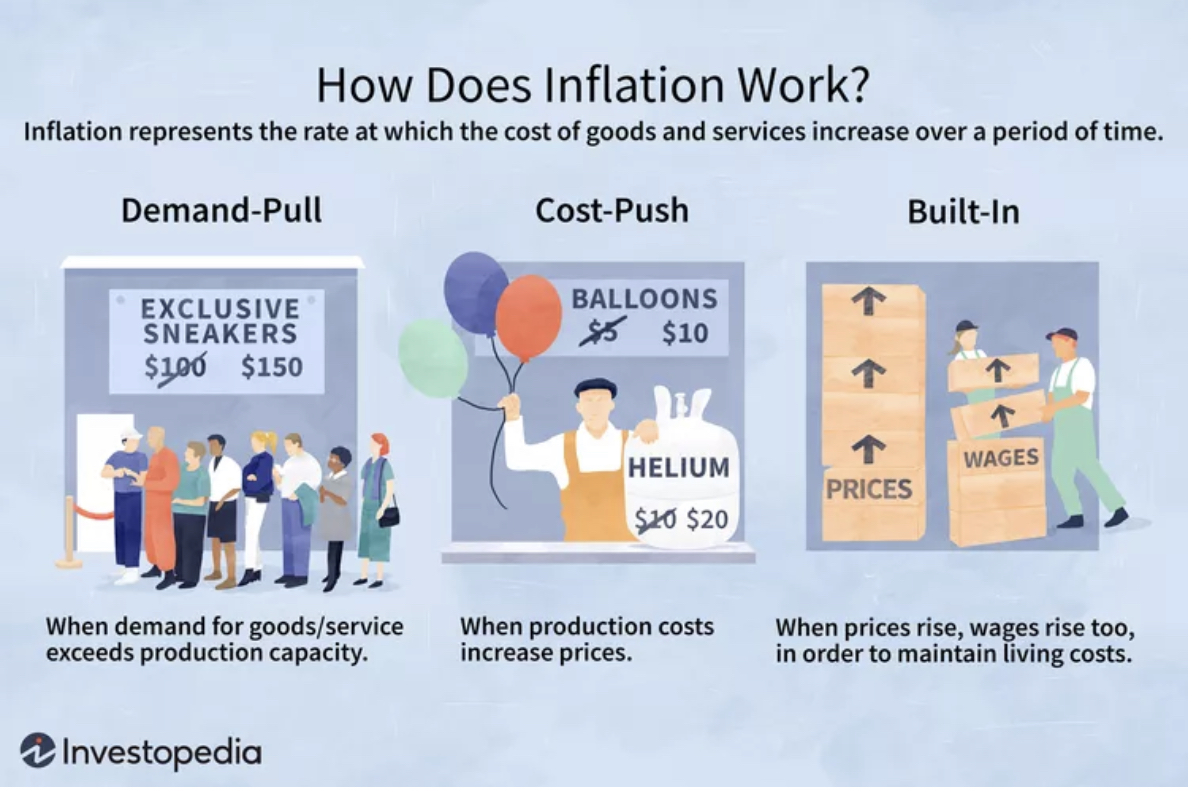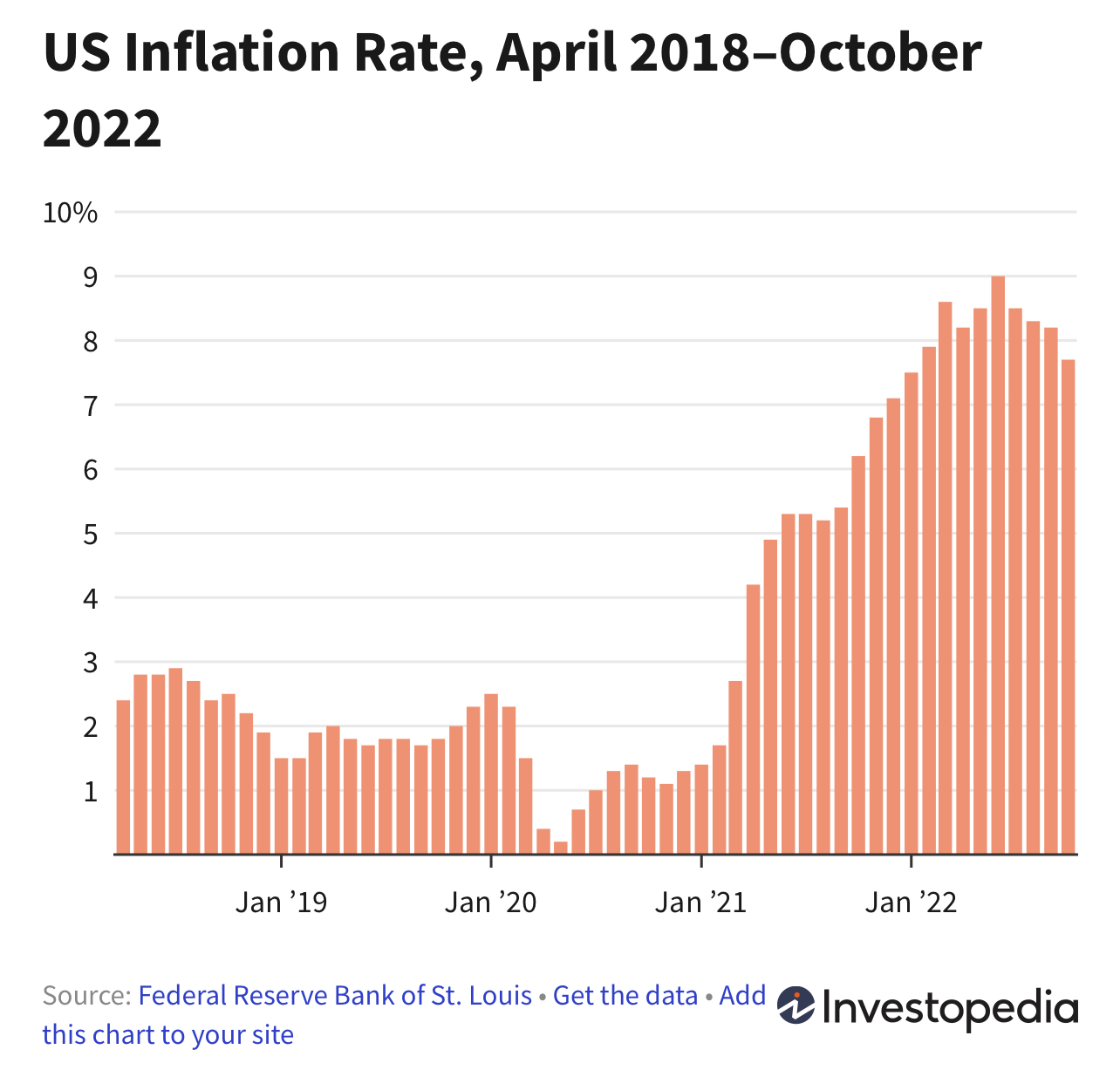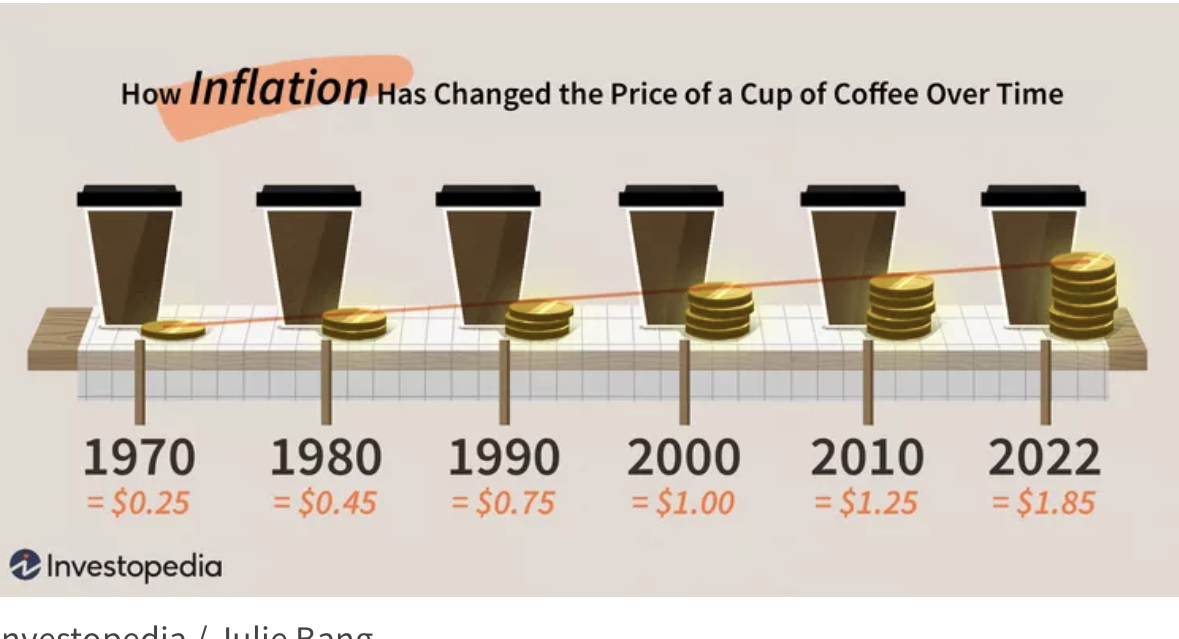Inflation is the rate at which the general level of prices for goods and services rises and, subsequently, purchasing power falls. It is measured as an annual percentage increase. When prices rise, each unit of currency buys fewer goods and services; consequently, inflation reflects a reduction in the purchasing power of money – a loss of real value in the medium of exchange and unit of account within an economy. A related concept is a cost-push inflation, which occurs when an increase in the cost of production leads to a higher general price level.
How is Inflation Measured?
Inflation is typically measured by the Consumer Price Index (CPI), which measures households’ average price level of a basket of consumer goods and services. The basket is constructed to reflect the consumption patterns of the average family, and the index is calculated by comparing the cost of the basket in a given period to the cost of the same basket in a base period. The percentage change in the cost of the basket over time is the inflation rate.
Another measure of inflation is the Producer Price Index (PPI), which measures the average change in prices received by domestic producers for their output. The PPI is a leading indicator of consumer price inflation, as the cost of goods and services at the producer level will eventually be passed on to the consumer level.
 Why Is Inflation So High Right Now?
Why Is Inflation So High Right Now?
Various factors, including an increase in the money supply, a decrease in the supply of goods and services, and an increase in production costs, can cause inflation. In recent years, the global economy has been recovering from the 2008 financial crisis and has been characterized by low-interest rates, which has led to an increase in the money supply and a corresponding rise in inflation. Additionally, the COVID-19 pandemic has led to supply chain disruptions and increased demand for certain goods and services, contributing to higher prices.
Advantages and Disadvantages of Inflation
Inflation can have both positive and negative effects on an economy. On the positive side, inflation can encourage spending and investment, as consumers and businesses may feel that prices will be higher in the future and, therefore, may be more likely to make purchases now. Additionally, inflation can reduce the debt burden, as the real value of debt is reduced with inflation.
On the negative side, inflation can lead to uncertainty and decreased consumer purchasing power. It can also lead to increased business costs, which may be passed on to consumers through higher prices. Additionally, inflation can lead to a redistribution of wealth, as those on fixed incomes may not be able to keep up with rising costs.
What Are the Effects of Inflation?
Inflation can have a variety of effects on an economy and individuals. On a macroeconomic level, inflation can lead to a decrease in purchasing power and a corresponding decrease in the standard of living for a country’s citizens. It can also lead to an increase in interest rates, as the central bank may attempt to curb inflation by raising rates. Additionally, inflation can lead to a decrease in the value of a country’s currency, as investors may be less likely to invest in a country with high inflation.
On a microeconomic level, inflation can affect individuals and businesses. For individuals, inflation can lead to a decrease in purchasing power and a corresponding decrease in the standard of living. For businesses, inflation can lead to increased costs, which may be passed on to consumers through higher prices. Additionally, inflation can lead to increased uncertainty and decreased investment.
What Causes Inflation?
Various factors, including an increase in the money supply, a decrease in the supply of goods and services, and an increase in production costs, can cause inflation. Some of the main causes of inflation include:
- Increase in the Money Supply: When the money supply increases, demand for goods and services can drive up prices. This is known as demand-pull inflation.
- Decrease in the Supply of Goods and Services: Prices can increase when the supply of goods and services decreases. Natural disasters, war, or reduced productivity can cause this.
- Increase in Production Costs: When the cost of production increases, businesses may pass on those costs to consumers in the form of higher prices. This is known as cost-push inflation.
- Imported Inflation: When prices of goods imported into a country increase, it can cause a general increase in the price level.
Is Inflation Good or Bad?
Inflation can have both positive and negative effects on an economy. A moderate inflation level is generally considered good for an economy, as it can encourage spending and investment. Additionally, an average level of inflation can reduce the debt burden, as the real value of debt is reduced with inflation.
 However, more inflation can be beneficial to an economy. High inflation can lead to decreased purchasing power and a corresponding decrease in the standard of living for a country’s citizens. It can also lead to increased costs for businesses, which may be passed on to consumers in the form of higher prices. Additionally, high inflation can lead to a redistribution of wealth, as those on fixed incomes may not be able to keep up with rising prices.
However, more inflation can be beneficial to an economy. High inflation can lead to decreased purchasing power and a corresponding decrease in the standard of living for a country’s citizens. It can also lead to increased costs for businesses, which may be passed on to consumers in the form of higher prices. Additionally, high inflation can lead to a redistribution of wealth, as those on fixed incomes may not be able to keep up with rising prices.
What is the difference between inflation and deflation?
Inflation and deflation are opposite economic conditions. Inflation refers to a sustained increase in the general price of goods and services in an economy, while deflation refers to a sustained decrease in the general price of goods and services. Inflation is measured as a positive percentage, while deflation is calculated as a negative percentage.
While inflation can have positive and negative effects on an economy, deflation is generally considered bad. Deflation can lead to decreased spending and investment, as consumers may delay purchases with the expectation that prices will be lower in the future. Additionally, deflation can increase the real value of debt, making it more difficult for individuals and businesses to repay their loans.
Historical Inflationary Periods
Throughout history, many examples of inflationary periods have had significant economic and social impacts. Some of the most notable examples include:
- The Great Inflation of the 1970s: This period was characterized by a sustained increase in the general price level of goods and services in the United States and other industrialized countries. The causes of this inflation were complex, but it was largely driven by a combination of factors, including an increase in the money supply, a decrease in the supply of goods and services due to the oil embargo, and an increase in production costs due to the Vietnam War. This period of inflation led to high-interest rates and economic stagnation, and it was only controlled in the early 1980s.
- The German Hyperinflation of the 1920s: This period of hyperinflation was characterized by a rapid and out-of-control increase in the general price level of goods and services in Germany. It was caused by a combination of factors, including the large amount of money printed by the German government to pay for World War I, a decrease in the supply of goods and services due to war reparations, and an increase in production costs. This period of hyperinflation led to a significant decline in the standard of living for Germans and contributed to the rise of the Nazi party.
- The Chinese inflation of the 1990s: This period was characterized by a sustained increase in China’s general price level of goods and services. It was caused by a combination of factors, including an increase in the money supply, a decrease in the supply of goods and services due to state-owned enterprises, and an increase in production costs. This period of inflation led to high-interest rates and economic stagnation, and it was only controlled in the early 2000s.
Inflation has been a recurring feature throughout history and can significantly impact the economy and society. Understanding historical inflationary periods and expectations are important to understand better the current economic conditions and the potential future direction of the economy. Furthermore, central banks need to be aware of the public’s inflation expectations and use the appropriate monetary policy tools to align them with their target rate to avoid inflation being too high or too low.
Inflation Expectations
Inflation expectations refer to the general public’s belief about the future inflation rate. A variety of factors, including the central bank’s actions, economic indicators, and political events, can influence these expectations. Inflation expectations are important because they can significantly impact financial decision-making. For example, if consumers and businesses expect inflation to be high in the future, they may be more likely to spend and invest now, leading to increased economic activity.
Central banks use various monetary policy tools to influence inflation expectations, such as adjusting interest rates, manipulating the money supply and quantitative easing. If central banks can successfully influence inflation expectations to align with their target rate, it could help them to achieve their inflation target, avoiding the risk of deflation or inflation that is too high.
In addition, inflation expectations can also impact the bond market, as investors will require a higher return to compensate for the expected inflation. The bond yields will increase, and the bond prices will decrease as the expected inflation rate rises.
How does inflation affect pricing?
Inflation affects pricing by increasing the economy’s cost of goods and services. As the general price level of goods and services increases, businesses may pass on the increased costs to consumers through higher prices. This can lead to a decrease in consumer purchasing power and a corresponding decrease in the standard of living.
Inflation can also lead to increased costs for businesses, which can impact their bottom line. For example, if production costs increase due to inflation, businesses may have to raise prices to maintain their profit margins. Additionally, inflation can lead to increased uncertainty and decreased investment, which can impact overall economic growth.

Inflation can also have a variety of effects on different sectors of the economy. For example, the prices of goods and services in the healthcare sector may increase more rapidly than in other sectors due to increased demand and decreased supply. Similarly, the prices of goods and services in the energy sector may grow more quickly due to the rising cost of oil and other inputs.
How does inflation today differ from historical inflation?
Inflation today differs from historical inflation in several ways. One of the main differences is the level of inflation. There have been periods of high inflation, such as the Great inflation of the 1970s, and periods of hyperinflation, such as the German Hyperinflation of the 1920s. Today, the inflation level is generally considered moderate, with most industrialized countries experiencing inflation rates of 2-3% per year.
The way central banks handle inflation today differs from the past. Today, most central banks use monetary policy tools such as interest rates and quantitative easing to influence inflation and stabilize the economy.
Inflation today differs from historical inflation in terms of the level and causes of inflation, as well as the way central banks handle inflation. While high and volatile inflation rates have characterized historical Inflation, Inflation today is generally considered moderate and stable. Additionally, while historical inflation was often caused by external factors such as war or natural disasters, today’s inflation is caused by more structural elements such as monetary policy and changes in demand and supply. Furthermore, central banks today have more tools to handle inflation and stabilize the economy compared to the past.
If you’re interested in learning more about gold IRAs and how they may fit into your overall financial plan, contact American Bullion today at 1-800-465-3472. We can provide the information and resources you need to make an informed decision about your future
The post What Is Inflation? first appeared on American Bullion.Original post here: What Is Inflation?
No comments:
Post a Comment